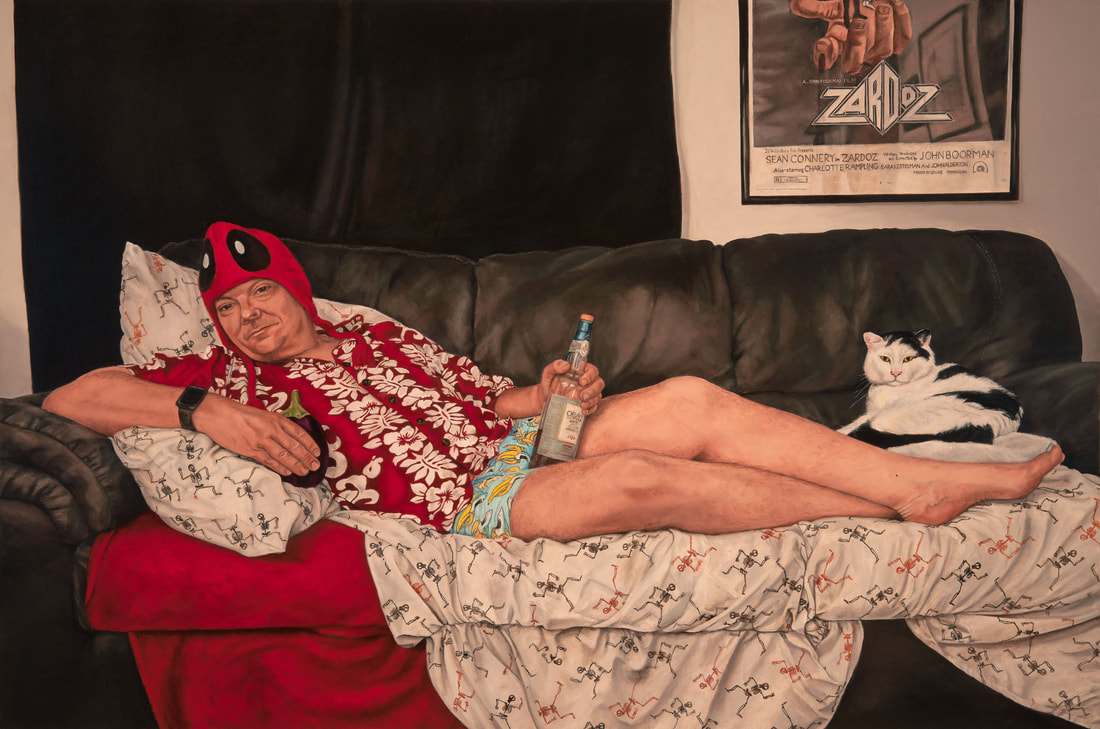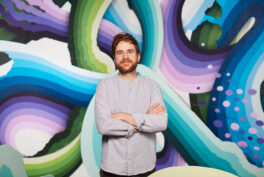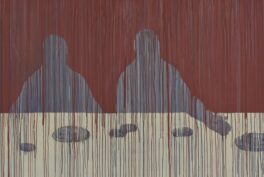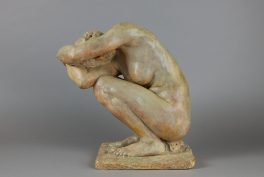The Interview
CB: Let’s start with a quick intro – who IS Klaire Lockheart?
KL: My origin story is that I sprung fully-formed from the head of Frida Kahlo! My work deals with feminist issues, challenging gender stereotypes. My intent is to give agency to women and help my audiences consider the value of all types of women. I am motivated to correct the dismal statistics of women in the art world.
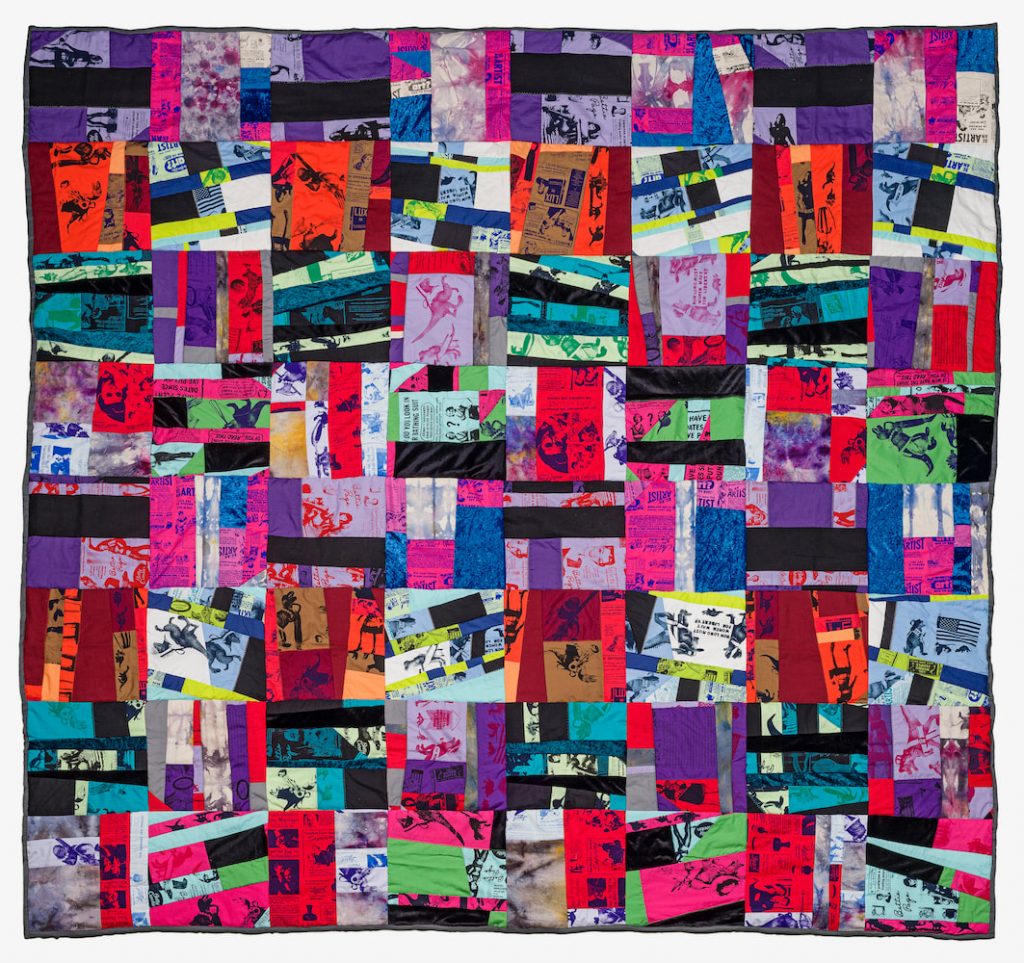
Klaire A. Lockheart, My Anger Keeps Me Warm at Night, ink and dye on fabric and canvas, 2020. Artist’s website.
CB: Your work is incredibly accessible – and funny!
KL: I am pleased to incorporate my sense of humor into my artwork in order to engage an audience that may not be ready to handle feminist artwork. I love the work of the Guerrilla Girls for this reason. Their ability to balance humor with serious issues impacts the way that I approach art!
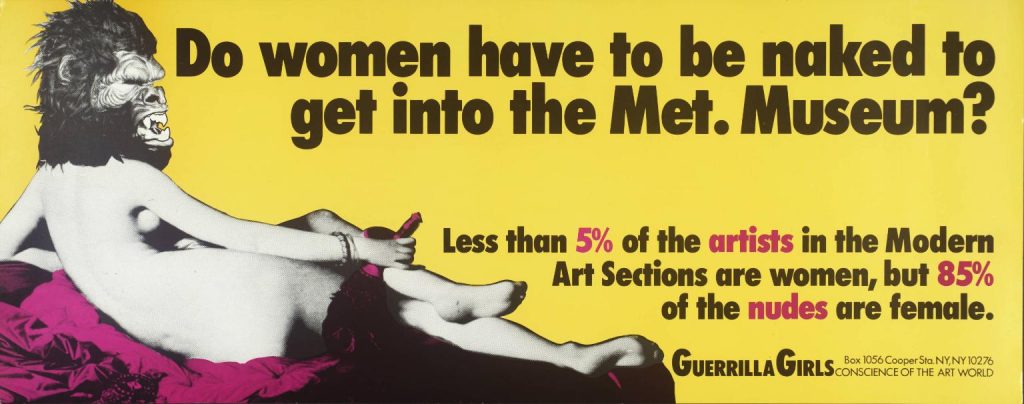
Guerrilla Girls, Do Women Have To Be Naked To Get Into the Met. Museum?, 1989, Tate, London, UK.
CB: In your work, you use diverse mediums from oils to photography, from audio podcasts to fibre and costume design. What appeals to you about exploring so many different mediums?
KL: I love the challenge of creating meaningful art and sharing my work with others. I specifically specialize in oil painting because it helps me engage with the academic history of art, which traditionally excluded women. My interest in fibre art grew out of creating costumes to use as references for my paintings, but now I create costumes and canvases independent of my paintings. I also appreciate podcasting because I am able to reach a wide audience.
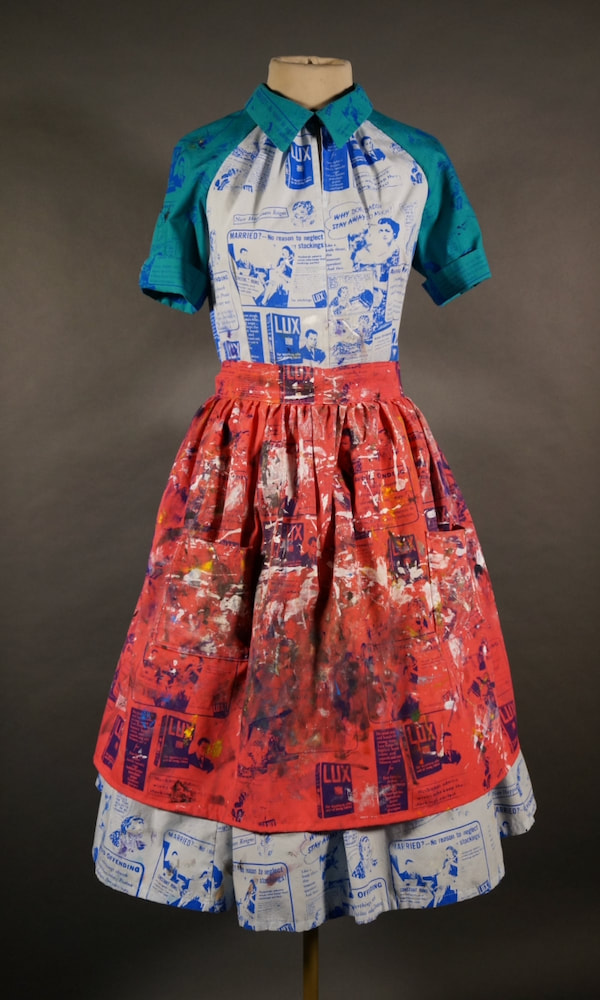
Klaire A. Lockheart, Lux Dress and Apron, Domestic Sarcasm series, 2015. Artist’s website.
CB: What do you want the viewer to see and feel when they engage with your work?
KL: I hope that viewers feel invited to engage with my work by my sense of humor, but after having a good chuckle, I want them to consider the bigger issues I address. I especially want my community to notice that artists who are women and other marginalized genders are often missing from American art institutions. I hope my audience will notice how women are traditionally depicted and start to question why. I feel that if women are respected in the art world, it could lead to an increase in respect for women in the real world.
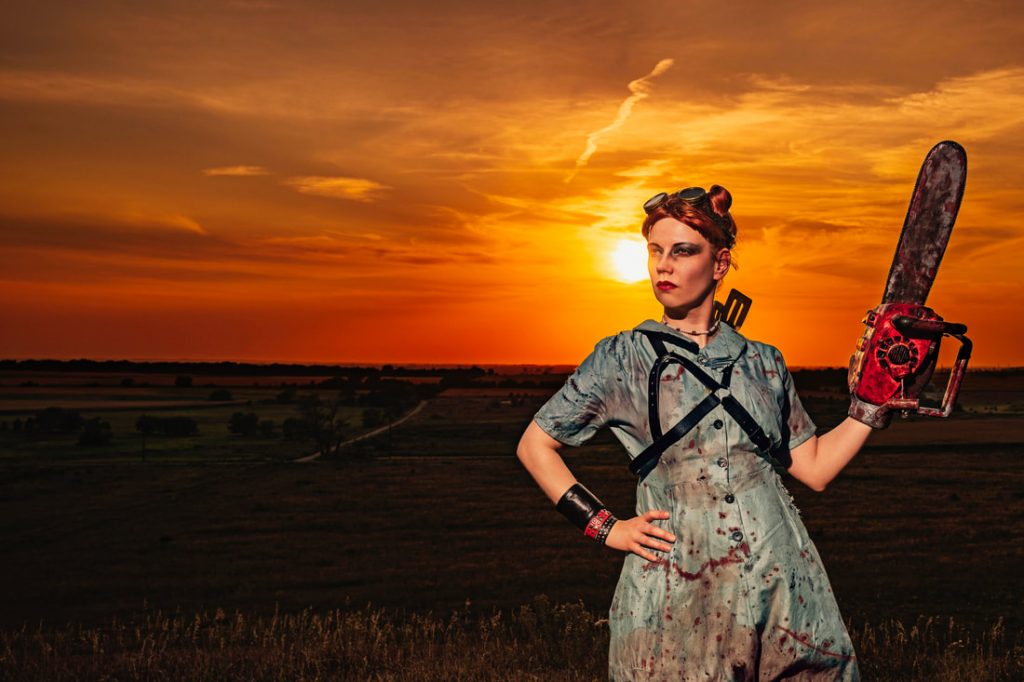
Klaire A. Lockheart and Aaron C. Packard, June of Arc, 2020. Artist’s website.
CB: Tell us about the Thunderdomesticity.
KL: The Thunderdomesticity series is a collaboration with my husband, the photographer Aaron C. Packard. It grew out of my nerdy appreciation of sci-fi, I Love Lucy, and bad post-apocalyptic movies. Because most post-apocalyptic narratives completely ignore or mistreat women, Aaron and I teamed up to invent a landscape populated by warrior women.
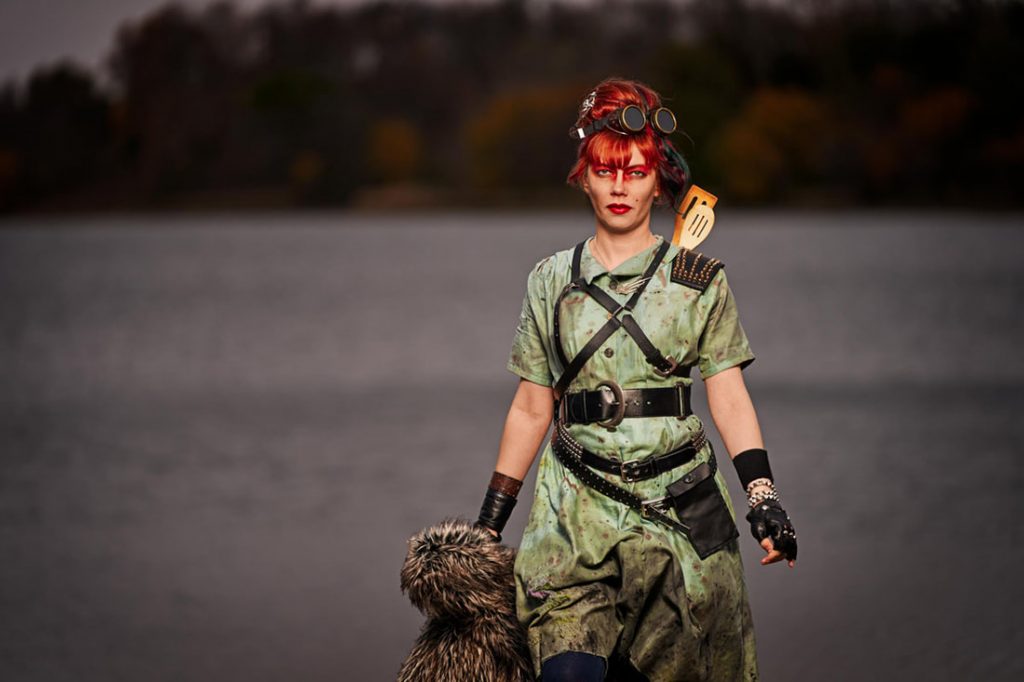
Klaire A. Lockheart and Aaron C. Packard, Double Barrel Slotted Spoon, 2020. Artist’s website.
CB: I understand audiences responded well to the Thunderdomesticity series?
KL: The Thunderdomesticity series is a direct response to the pandemic and isolation, and I am floored at how many people relate to this concept. I have had such a positive response to the final photography and to the behind-the-scenes images! For my birthday this year, I organized a small group exhibition called Femininity in the PostApocalypse and invited attendees to make their own Thunderdomesticity-style costumes. I was surprised at how many people made costumes specifically for this event! It made me incredibly happy to know that something I created resonated with so many other people during this weird point in history.
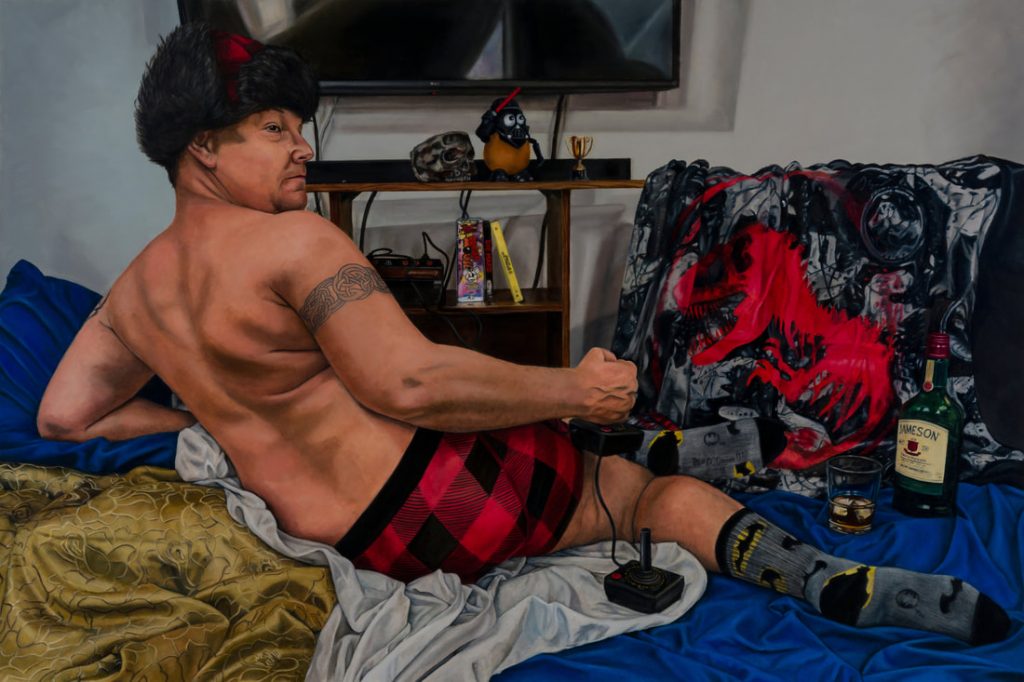
Klaire A. Lockheart, Grande Brodalisque, 2021. Artist’s website.
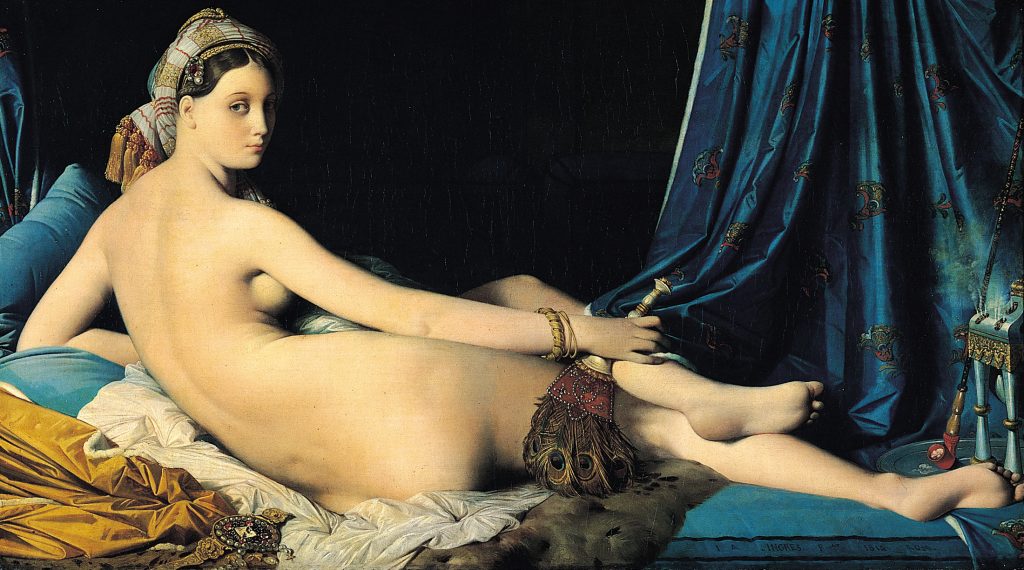
Jean Auguste Dominique Ingres, La Grande Odalisque, 1814, Louvre, Paris, France.
CB: The Brodalisques series is a fascinating dialogue with traditional art history. Could you tell us about these paintings?
KL: My Brodalisques are a direct reaction to Odalisque paintings, Orientalism and traditional Euro-centric paintings that objectified women, which contemporary audiences often accept as ‘Art’ without question. I have to paint better than Jean-Auguste-Dominique Ingres and Jean-Léon Gérôme in order to have a valid argument.
Note to readers: An Odalisque is a highly eroticized fantasy of a male artist. These paintings show a naked woman (a concubine or slave), reclining in a suggestive pose, in a harem. So many artists have their own version of the Odalisque, and without exception, these images idealize and objectify the female form. Most European artists held very stereotypical views about what ‘the Orient’ and ‘the East’ meant, appropriating exotic culture and imagery that fitted with their colonial politics.
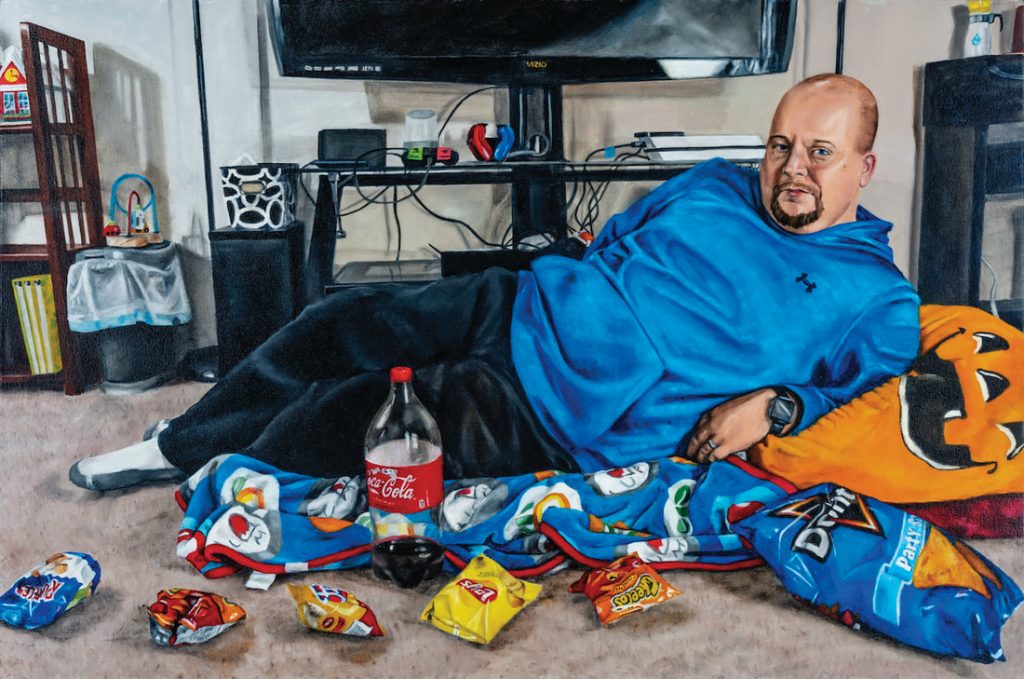
Klaire A. Lockheart, Brodalisque with Black Trousers, 2020. Artist’s website.
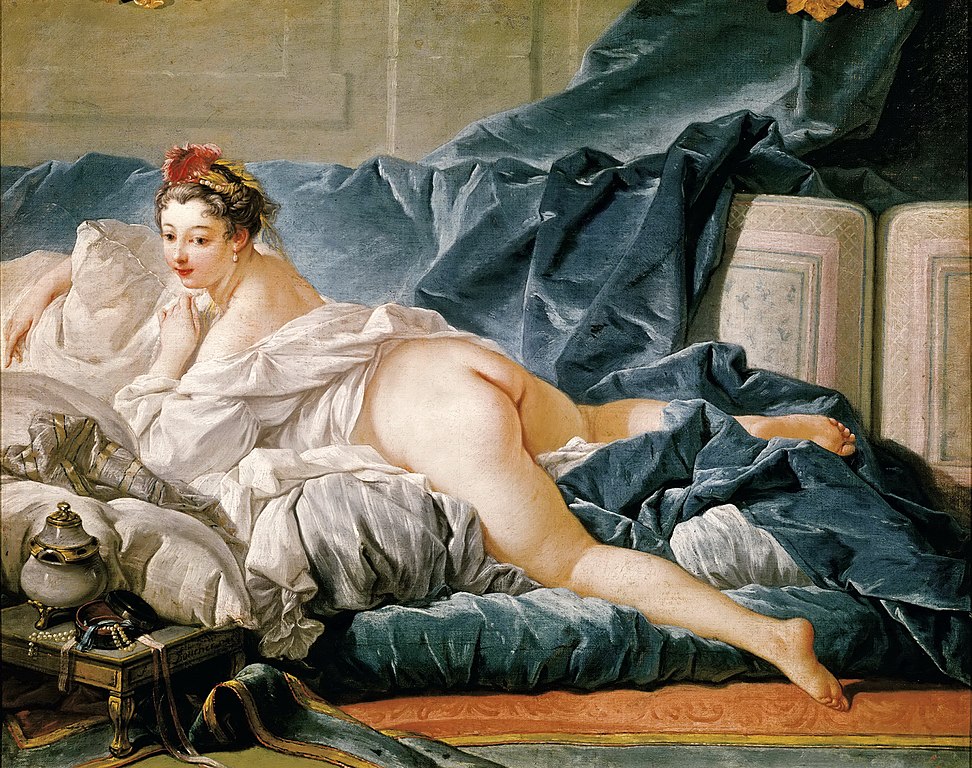
Francois Boucher, Odalisque Brune, 1745, Louvre, Paris, France.
CB: Who sits for your Brodalisque paintings?
KL: All of my brodalisque models are in on the joke, and many of them are artists who understand the history of Orientalism and the problematic qualities of the male gaze. It is a little challenging to get men to agree to let me paint them, but once I explain the purpose and they see my previous work, they’re on board! I’m biased, but my favorite model is my husband!
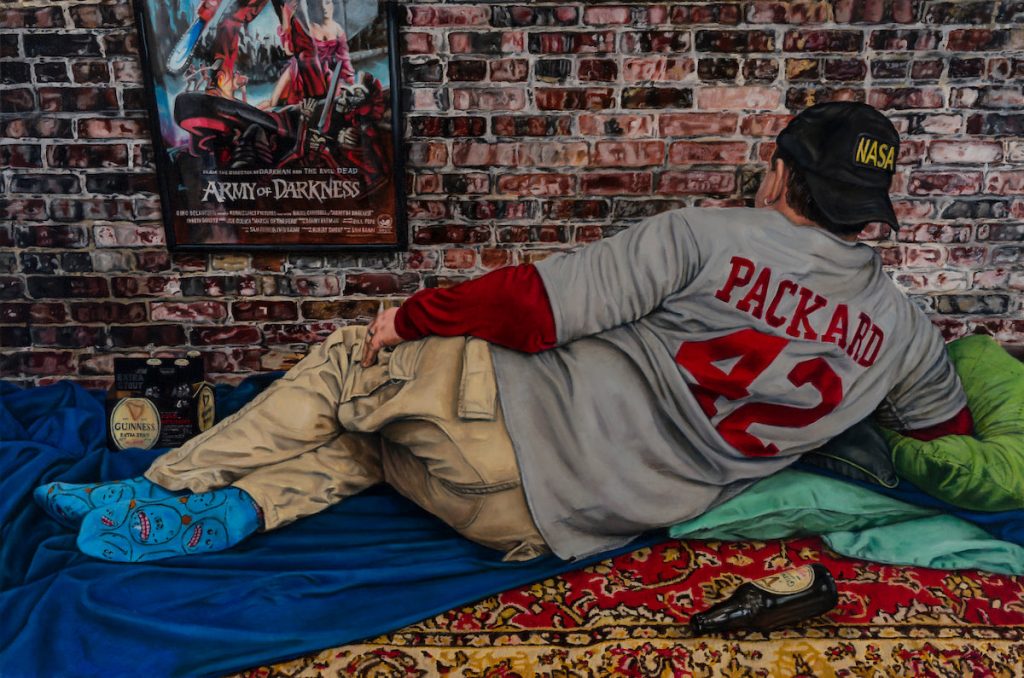
Klaire A. Lockheart, Brodalisque Reclining in the Basement, 2021. Artist’s website.
CB: Your Brodalisques are mainly clothed (unlike their historical female counterparts). What was your thinking on this?
KL: Because I live in a rural area, there aren’t very many opportunities for me to display my art, and I have been told in the past that if I painted nude men I wouldn’t be able to display my artwork. Ironically, nude women’s bodies on display are deemed acceptable in my region. When I paint my brodalisques clothed, it allows me more opportunities to show my work, which permits me to engage with my audience in order to highlight this double standard.
KL: When I depict lounging men, I am able to spark the realization for many viewers that women have been traditionally painted in these passive poses for centuries without question. I also enjoy painting my models in their “bro” costuming because it helps set the scene and places me firmly in the 21st century.
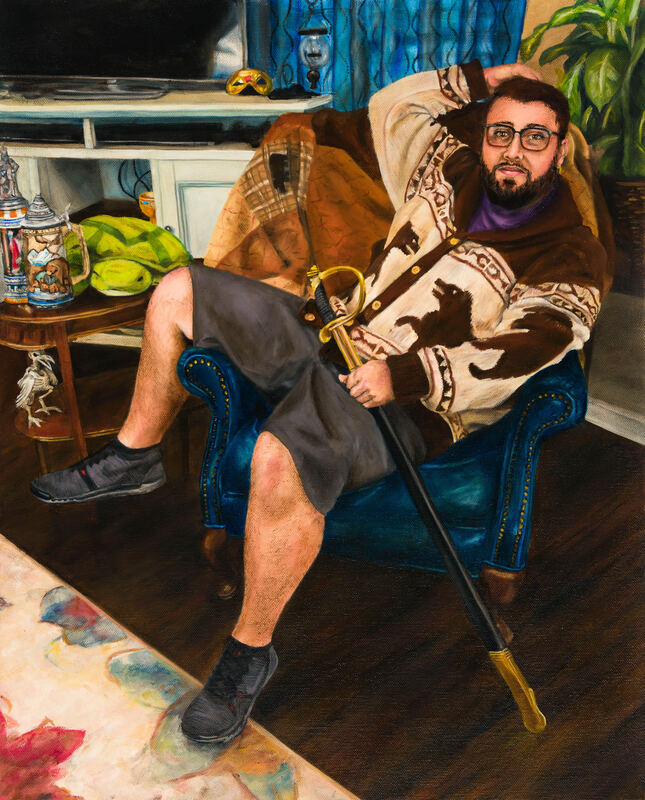
Klaire A. Lockheart, Seated Brodalisque, 2020. Artist’s website.
CB: What, apart from your work, brings you pleasure?
KL: I love having arguments with old dead guys, including philosophers, misogynists, and colonizers. I’m a huge nerd, and I recommend Yours Cruelly, Elvira by Cassandra Peterson to my goth, funny, and feminist friends. It’s probably not surprising that Halloween is my favorite holiday! I like to plan and host memorable and weird events for my friends.
CB: Whose artworks are you excited by?
KL: I am proud to carry on the legacy of other amazing artists including Artemisia Gentileschi, Claude Cahun, and Frida Kahlo. As for contemporary artists, I am inspired by Katherine Cooksey, Suzanne Heintz, Reyna Hernandez, and Kelly Reemtsen.
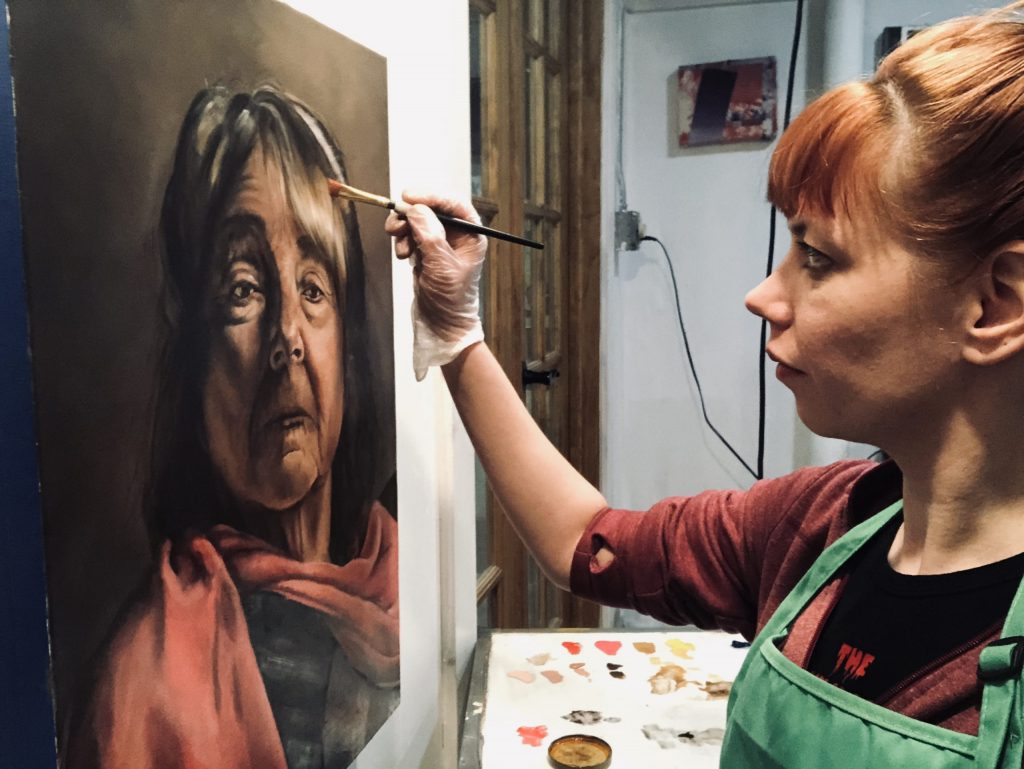
Klaire A. Lockheart in the studio, 2022. Artist’s Facebook page.
CB: Do you see yourself as part of an arts tradition?
KL: I see myself as an extension of the traditional European academic style of art. I purposefully use oils and paint in the ‘realistic’ style because women were traditionally excluded from training as artists and were historically forbidden from studying the human figure. Once women were finally admitted to nude drawing classes, the art world shifted and figure painting was no longer considered cool. It’s not fair. I want my time. I want to correct this historical discrimination.
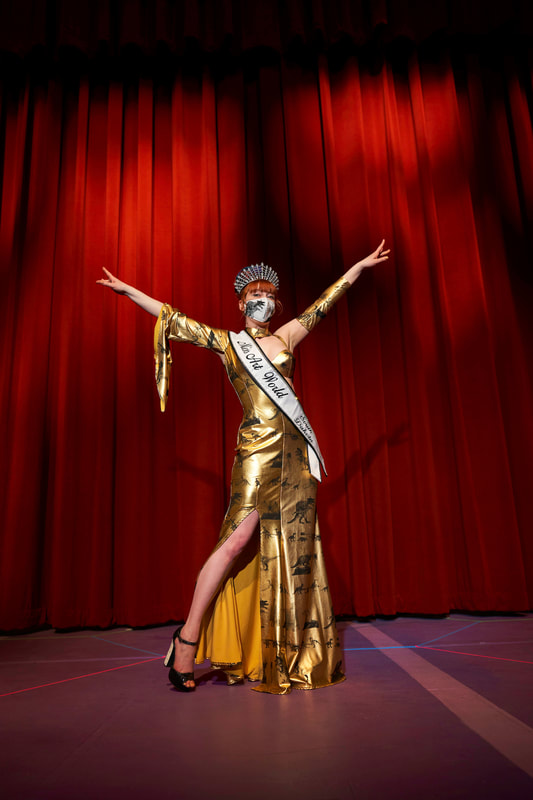
Katherine Cooksey’s Miss Art World project, with Klaire A Lockheart as Miss Art World South Dakota, 2021. Photo by Aaron C Packard.
CB: And are you part of an ‘art scene’?
KL: I am part of the Miss Art World family created by conceptual artist Katherine Cooksey, who is based in Los Angeles. During Women’s History Month in 2021, I was crowned Miss Art World South Dakota.
CB: What advice would you have for young artists starting out today?
KL: My first painting instructor in graduate school, Chelsey Wood, always emphasized that in order to paint well, you have to paint a lot. She was right!
KL: Also, reach out to artists you admire! Sign up for mailing lists, like their social media posts, and attend local receptions. The arts are often overlooked and underfunded, and it’s important for artists to support each other. This is especially important in rural areas, because we have bigger impacts on our art communities. Don’t be afraid to experiment and try new things. Sometimes, I create total failures, which is completely okay. I view these challenges as learning experiences, which make me a stronger artist overall.
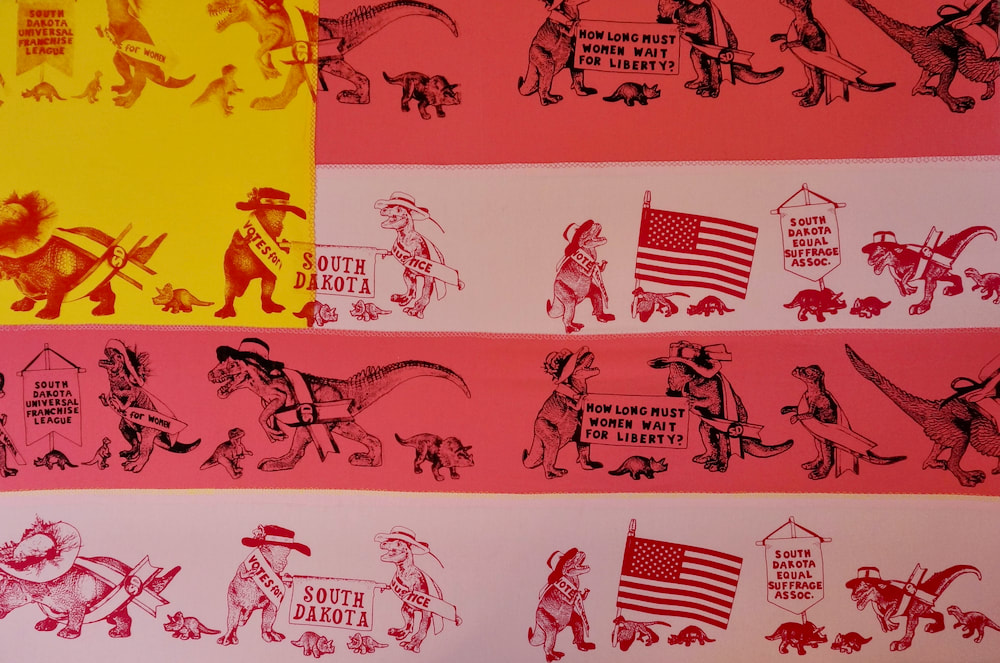
Klaire A. Lockheart, Suffragist Sue Flag, Ink on fabric on Canvas. 2020. Artist’s website.
CB: You’ve been exhibiting pretty solidly since 2010, what have been the highlights? Is it hard work getting your name out there?
KL: I live in rural South Dakota, and it is difficult to exhibit my artwork because there aren’t very many opportunities. It’s a challenge, and so I have to spend a lot of time seeking out opportunities and applying for exhibitions across multiple states. I’m very lucky to have a studio space that’s only a few blocks away from my home, which is part of the Vermillion Area Arts Council.
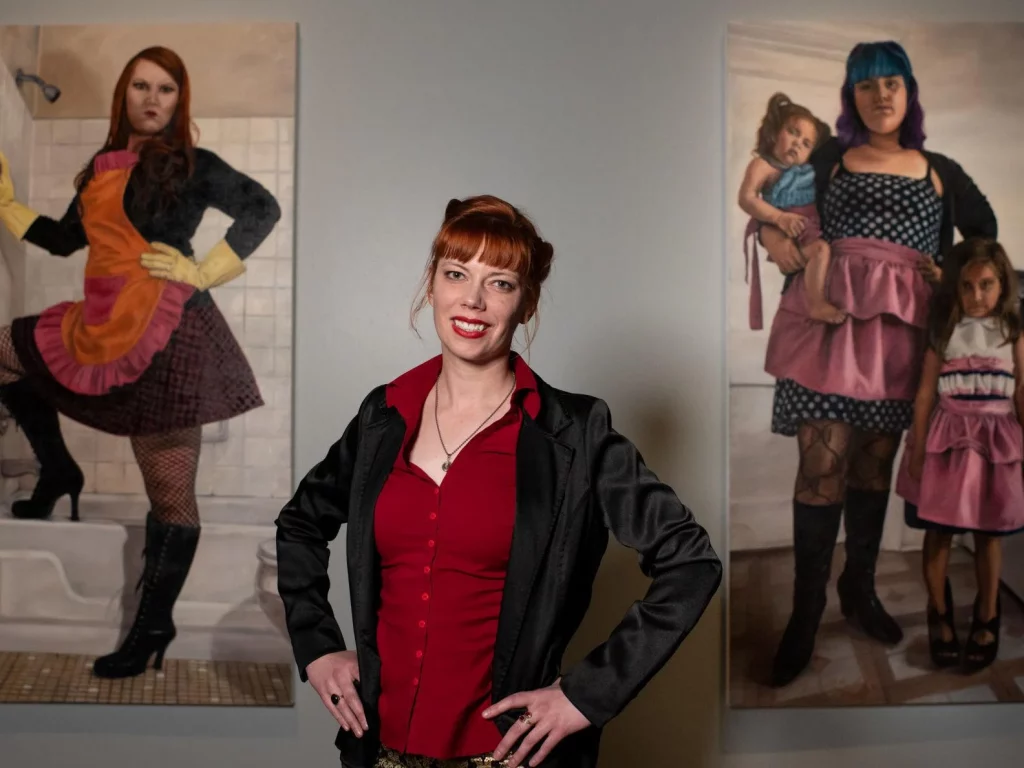
Klaire A Lockheart, paintings from the Feminine Attempts series, 2014-16. Artist’s Facebook page.
CB: You are an instructor at Morningside University and have taught at the University of South Dakota. And you’ve been teaching in schools and summer camps for years. Can you tell us about that? How do you feel about teaching?
KL: I have designed curriculum and taught art for everyone from junior kindergarten through graduate school, and at my core I am an educator. I also feel pride when my friends and students experience success. I want people to learn, grow, and improve the world around them. I am conflicted about teaching as profession because it is vital and important, but I am not on board with the terrible treatment of public educators in the United States.
KL: I love making a positive impact with my art and helping my friends and community empathize with others. To be completely honest, I do not feel appreciated or respected as an artist or a person in South Dakota because there is a severe lack of art education, funding, and our government likes to discriminate against women and LGBTQ+ people. However, I can’t imagine my life outside the field of art. Before I earned my MFA, I was a full-time public school art teacher. It’s cheesy, but I am driven to make a difference.
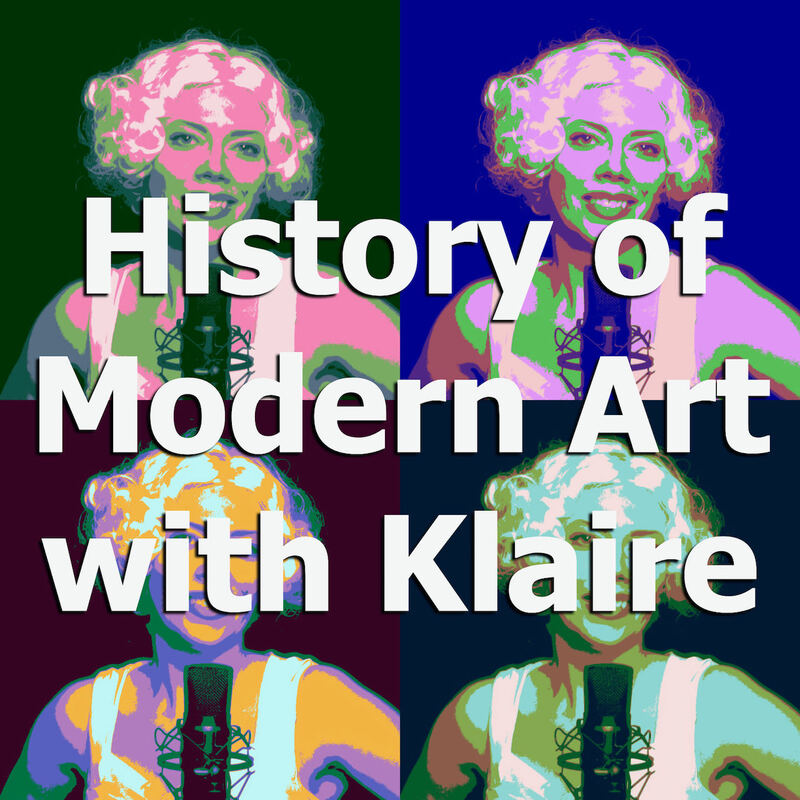
Klaire A Lockheart, The History of Modern Art with Klaire, podcast cover. Artist’s website.
CB: Your History of Modern Art podcasts are some of the most interesting and accessible pieces I have heard in a long time. Was this a natural progression from your own art studies and from your teaching work?
KL: I created The History of Modern Art with Klaire because I struggle with Modernism despite the amount of effort and study I have dedicated towards it, and I understand that many people also have difficulty relating to modern art. When my friends found out that I was going to teach Modern Art last year, they expressed a desire to sneak into my class so they could learn from me. To help them out, I committed to create my podcast, which is a chronological romp through Western modern art history viewed through an intersectional feminist lens. My goal was to break down complex concepts in a way that contemporary audiences can grasp.
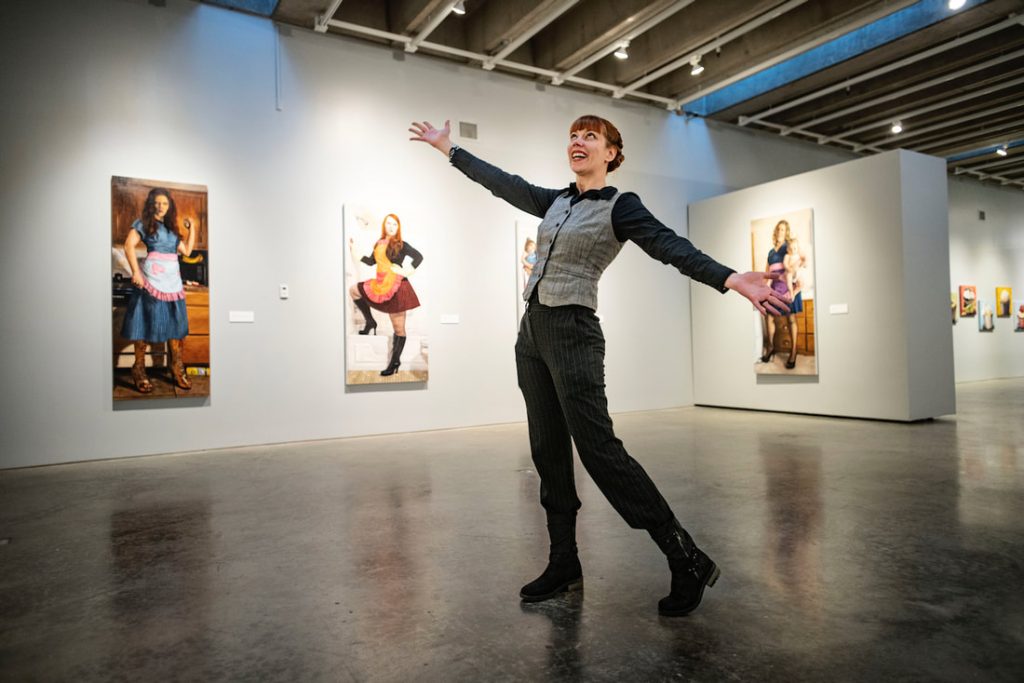
Klaire A Lockheart, gallery opening of Feminine Attempts, 2019, Sioux City Arts Centre, IA, USA. Artist’s website.
CB: And finally, how do you feel about the future?
KL: I have more Brodalisques planned, and I am working on new Thunderdomesticity costumes. It’s weird and exciting when I finish a work. I love to share my progress on social media, but it’s fun to celebrate when the work is ready for its public debut! I would love to see my artwork in private and public collections. I hope there will be a chapter in future art history books dedicated to the Miss Art World movement, and I would be more than happy to see a few paragraphs dedicated to artwork I created. I’m motivated to create so much art that we’ll kick off a new Renaissance, and I’ll get a Ninja Turtle named after me!
You can see more of Klaire A Lockheart’s works on her website!
